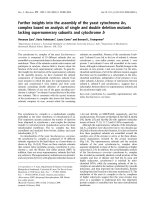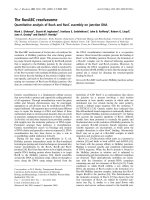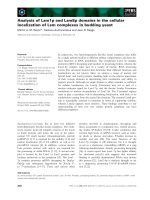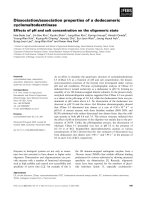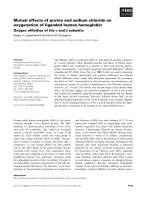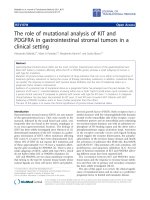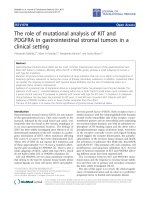cross-country analysis of the effects of e-banking and financial infrastructure on financial sector competition a schumpeterian shift
Bạn đang xem bản rút gọn của tài liệu. Xem và tải ngay bản đầy đủ của tài liệu tại đây (1.78 MB, 170 trang )
A CROSS-COUNTRY ANALYSIS OF THE EFFECTS OF E-BANKING
AND FINANCIAL INFRASTRUCTURE ON FINANCIAL SECTOR COMPETITION:
A SCHUMPETERIAN SHIFT?
By
Jennifer Isern
A DISSERTATION
Submitted to
H. Wayne Huizenga School of Business and Entrepreneurship
Nova Southeastern University
in partial fulfillment of the requirements
for the degree of
DOCTOR OF BUSINESS ADMINISTRATION
2008
3301304
3301304
2009
Copyright 2008 by
Isern, Jennifer
All rights reserved
A Dissertation
Entitled
A CROSS-COUNTRY ANALYSIS OF THE EFFECTS OF E-BANKING
AND FINANCIAL INFRASTRUCTURE ON FINANCIAL SECTOR COMPETITION:
A SCHUMPETERIAN SHIFT?
By
Jennifer Isern
We hereby certify that this Dissertation submitted by Jennifer Isern conforms to
acceptable standards, and as such is fully adequate in scope and quality. It is therefore
approved as the fulfillment of the Dissertation requirements for the Degree of Doctor of
Business Administration.
Approved:
Paul Dion, Ph.D. Date
Chairperson
Barry Barnes, Ph.D. Date
Committee Member
Ira Lieberman, Ph.D. Date
Committee member
Russell Abratt, Ph.D. Date
Associate Dean of Internal Affairs
J. Preston Jones, D.B.A. Date
Executive Associate Dean,
H. Wayne Huizenga School of Business and Entrepreneurship
Nova Southeastern University
2008
CERTIFICATION STATEMENT
I hereby certify that this paper constitutes my own product, that where the language of
others is set forth, quotation marks so indicate, and appropriate credit is given where I
have used the language, ideas, expressions or writings of another.
Signed_____________________________
Jennifer Isern
ABSTRACT
A CROSS-COUNTRY ANALYSIS OF THE EFFECTS OF E-BANKING
AND FINANCIAL INFRASTRUCTURE ON FINANCIAL SECTOR COMPETITION:
A SCHUMPETERIAN SHIFT?
by
Jennifer Isern
New forces are taking hold in the financial services industry that may change existing
competition paradigms. Electronic banking is thriving in Japan, Europe, South Africa,
the Philippines, and the US as clients click their mouse, press telephone keys, and slide
cards to conduct their banking. In parallel, credit registries reduce information
asymmetry and contribute to lower costs and increased lending volume. Increasingly,
banks and other financial service providers are starting to launch many of these same
innovations in developing countries. Emerging markets are in the position of developing
financial infrastructure that could leapfrog those in established markets and provide a
broader range of financial services for clients. Financial services may be entering a
period of Schumpeterian competition in which electronic banking and financial
infrastructure may fundamentally change the global financial services industry.
To identify the cross-country determinants of competition, panel data on 1,514 banks was
gathered from the BankScope database of financial statements for 2004-2006 for a range
of banks from 185 countries. Applying the Panzar and Rosse (1987) model for
competition, this study determined the effect of e-banking and financial infrastructure on
bank competition. Other classic factors of competition such as country-level factors,
financial sector policy, and client factors were also analyzed. The research findings
include a positive relationship between the level of financial infrastructure and the level
of competition and a negative relationship between the degree of state ownership in a
banking sector and the level of competition. This study helps to extend competition
theory to include electronic banking and financial infrastructure.
Keywords: banking, competition, electronic banking, financial infrastructure, credit
registries, payment systems, financial services, financial sector development.
ACKNOWLEDGEMENTS
“The more I learn, the more I realize I don’t know.”
Albert Einstein
I feel incredibly fortunate that my dissertation committee consisted of Dr. Paul Dion, Dr.
Barry Barnes, and Dr. Ira Lieberman. These three gentlemen generously shared their
time, expertise, guidance, and encouragement over the past year. I am grateful for their
invaluable contributions that led to higher quality research and my deeper understanding
of the issues and research findings.
The Staff and Faculty of the Doctoral Program have given me wonderful assistance and
encouragement throughout my classes and dissertation research.
I would like to thank those dear souls who kept me afloat with their love, support,
enthusiasm, and patience throughout this endeavor. I am grateful to Elizabeth, Mom,
Lori, Pam, Brian, Doug, and many more family, friends, and colleagues.
Finally, I offer my heartfelt gratitude to my mother, father, grandmother and grandfather,
who shared their love of reading and learning with me from my earliest memories. In
their own special ways, they each showed me that education and lifelong learning truly is
the key to the future.
vi
TABLE OF CONTENTS
List of Tables ix
List of Figures x
Chapter
1. INTRODUCTION 1
Introduction 1
Background 2
Purpose and justification of the study 3
Research outline 6
Problem statement 6
Research question 6
Research model 6
Conclusion 8
2. LITERATURE REVIEW 9
Introduction 9
The role of the financial sector 10
Concentration and competition 15
Measuring competition and concentration 16
Mitigating factors for competition 18
Market structure 20
Payment systems 22
Credit registries 23
Authorized scope of financial services 25
Foreign ownership 26
State ownership 28
Geographic concentration 30
E-banking 30
Building blocks of e-banking 31
Experience in developed markets 35
Pilots in emerging markets 42
Factors influencing the adoption of e-banking 46
Institutional factors 47
Clients 50
Government’s role: Regulation and infrastructure 53
Effects of e-banking and payments infrastructure on efficiency and
competition 56
Cost and economies of scale 56
vii
Client service 61
Conclusion 62
3. METHODOLOGY 65
Introduction 65
Research question 65
Hypotheses 65
Research design 68
Variables and sources of data 70
Dependent variable 70
Independent variables 70
Data collection 78
Data coding 79
Population 79
Data analysis 80
Analytical and statistical techniques 80
Treatments 80
Analysis 80
Assumptions and limitations 83
Conclusion 85
4. ANALYSIS AND FINDINGS 87
Introduction 87
Presentation of the data 87
Descriptive statistics 89
H-statistic 89
Market equilibrium statistic 93
Determinants of competition indicators 96
Results of hypothesis testing 99
Hypothesis 1 100
Hypothesis 2 101
Hypothesis 3 102
Hypothesis 4 103
Hypothesis 5 103
Hypothesis 6 104
Summary of hypothesis testing 105
Conclusion 106
5. SUMMARY AND CONCLUSIONS 107
Overview of significant findings 107
Implications of this study to current theory in the discipline 109
Limitations of this study 110
Implications of the findings for market players 113
viii
Recommendations for future research 114
Conclusion 115
APPENDICES
1. Frequency tables 116
2. Correlation matrices 118
3. H-statistics of banking system for selected countries 124
4. Market equilibrium statistics of banking system for selected countries 132
5. Distribution tables 137
REFERENCES CITED 142
ix
LIST OF TABLES
Table
1. Common e-banking services 33
2. Bank and retailer costs per payment transaction 58
3. Description and definition of financial service provider variables and
data sources 70
4. Description and definition of country-level variables and data sources 72
5. Description and definition of variables and data sources to calculate
market equilibrium per country 84
6. Regression results: Cross-country determinants of H-statistic 97
7. Summary of hypotheses, testing and statistical technique 105
8. Variable frequencies to calculate the H-statistic 117
9. Variable frequencies to calculate the market equilibrium statistic 117
10. Correlation matrix for variables to calculate the H-statistic 119
11. Correlation matrix for variables to calculate the market equilibrium statistic 120
12. Correlation matrix for cross-country determinants of competition 121
13. H-statistics of banking systems for selected countries 125
14. Countries where H-statistic is not significantly different from zero 129
15. Countries where H-statistic is not significantly different from one 130
16. Market equilibrium statistics of banking systems for selected countries 133
17. Distribution of variables for cross-country determinants of competition 138
18. Skewness, kurtosis and Kolmogorov-Smirnov test for cross-country
determinants of competition 139
x
LIST OF FIGURES
Figure
1. Evolution in the US Non-Cash Payment Activity, 2000-2003 37
2. Number of Non-Cash Payments Per Capita, Selected Economies, 2003 38
3. Marginal Cost of Transactions in the United States, by Mode of Delivery 57
4. Research design 69
1
CHAPTER 1
INTRODUCTION
Introduction
This research analyzed the dynamics of competition in the financial services
industry and theories of competition that explain sometimes counter-intuitive effects
observed over the last fifty years. Specifically, the research addressed the following
question: How does electronic banking and financial infrastructure influence competition
in the financial services industry?
New forces are taking hold in the financial services industry that may change
existing competition paradigms. Electronic banking is thriving in Japan, Europe, South
Africa, the Philippines, and the US as clients click their mouse, press telephone keys, and
slide cards to conduct their banking. In parallel, credit registries are helping to reduce
information asymmetry and contribute to lower costs and increased lending volume.
Increasingly, banks and other financial service providers are starting to launch many of
these same innovations in developing countries.
Emerging markets are in the position of developing a financial infrastructure that
could leapfrog those in established markets to provide a broader range of financial
services for clients. The 2007 sub-prime mortgage crisis in the US and spillover effects
across financial markets globally in 2007-2008 may cause banks to change strategies that
could accelerate adoption of more efficient techniques such as electronic banking, credit
registries, and payment services. In sum, financial services may be entering a period of
2
Schumpeterian competition (Schumpeter, 1942) in which electronic banking and
financial infrastructure may fundamentally change the global financial services industry.
This chapter begins by summarizing the role of the financial sector in national
economic development, competitive issues in financial services, and the potential role of
electronic banking in changing competitive forces. The second section provides an
outline for the study, including sample selection procedures, hypotheses and research
design.
Background
Banks and other regulated financial services providers play a key role in a
country’s economic development (Cameron, 1967; Stiglitz & Weiss, 1981; Levine, 2004;
Levine, Loayza & Beck, 2000; Demirguc-Kunt & Levine, 2001). Given its strategic
importance, policy makers, researchers and the private sector all need to understand the
complex dynamics that affect the financial sector.
Within an existing regulatory environment and given national government control
of inflation and monetary policy, competition and concentration determine bank behavior
and the countenance of appropriate risk levels. Bank concentration and competition, both
core elements of market structure, are key drivers affecting financial sector performance
(Chandler, 1938; Berger & Hannan, 1989; Allen & Gale, 2000, 2004; Claessens &
Laeven, 2004; Berger, Demirguc-Kunt, Levine & Haubrich, 2004).
The Panzar and Rosse (1987) model explored competition by analyzing the
elasticity of bank profit to the bank’s input prices. In a perfectly competitive market, an
increase in input costs results in an equal increase in both marginal cost and marginal
revenue. However, in a monopolistic market, an increase in input costs results in
3
increased marginal costs, decreased output, and decreased total revenue. The Panzar and
Rosse model has been applied extensively to banking markets in the United States,
Canada, Europe, Japan, and an increasing number of regions and countries (Shaffer,
1982; Molyneux, Thornton & Lloyd-Williams, 1996; Bikker & Haaf, 2002; Gelos &
Roldos, 2002; Yildirim & Philippatos, 2003; Claessens & Laeven, 2004; Drakos &
Konstantinou, 2005; Staikouras & Koutsomanoli-Fillipaki, 2006). Researchers have
analyzed the effects of market structure, financial infrastructure, authorized scope of
financial services, foreign ownership, and geographic concentration on bank
concentration and competition, as discussed in Chapter 2.
Purpose and Justification of the Study
This study contributes to financial sector research and policy by investigating the
effect of electronic banking and financial infrastructure on financial sector competition
across selected developed and developing countries.
The implementation of e-banking has the potential to affect the economic growth
rate of developing countries if it significantly enhances efficiency and extends the reach
of financial services. Evidence is accumulating that e-banking and payments
infrastructure are reshaping the structure and nature of the financial services industry
(Isern, 2007; Isern, Donges & Smith, 2006; Allen, McAndrews & Strahan, 2002; Nsouli
& Schaechter, 2002; Claessens, Glaessner & Klingebiel, 2002). By reducing information
asymmetry, credit registries can increase competition among banks, reduce interest rates,
and increase lending volume (Djankov, McLiesh & Shleifer, 2007; Bátiz-Lazo, 2004;
Love & Mylenko, 2003; Miller, 2003; Padilla & Pagano, 1997; Vercammen, 1995).
4
The adoption of e-banking and other financial infrastructure could greatly lower
the cost of financial services and provide substantially greater access to firms and
individuals. By increasing efficiency of operations, e-banking can increase economies of
scale that could lead to greater consolidation of the financial services industry (Allen et
al., 2002). Given these findings and the ongoing evolution in the industry, it seems
likely that new services, new delivery channels, and new or hybrid institutions competing
for clients will significantly change the financial services industry.
The financial services industry may be entering a period of Schumpeterian
competition (Schumpeter, 1942) and creative destruction where innovations may
radically change the nature of competition. Under these conditions, inventive new firms
gain market power while older, more established firms must change or fade away if they
cannot compete effectively in the new market realities.
The 2007 downturn in US sub-prime mortgages and special purpose vehicles has
developed into a broader financial crisis. Weak performance in other financial services
includes credit cards, car loans, and leveraged buy-out loans. The financial crisis has
spread beyond the US with strong ripple effects in Europe, Asia, and other regions.
Often in financial crises, financial service providers retreat to quality and adopt more
conservative strategies. One scenario is that banks scale back expansion or capital
investment plans, thereby reducing investments in new banking technologies. However,
banks may also seek greater operating efficiencies, fewer physical branch offices, and
diversified clientele facilitated by electronic banking, credit registries, and payments
platforms.
5
E-banking and payment systems may have surprising effects on competition in
the financial sector, including costs and economies of scale, new entrants and institutional
competition, and customer demand for higher service quality. E-banking can
substantially increase the number of transactions and clients that a firm can manage, and
this leads to efficiency gains (Humphrey & Pulley, 1998). E-banking allows banks and
other financial service providers to offer clients another service, and one that may
increase customer loyalty (Mullaney & Little, 2002; Turban, Lee, King & Chung, 2000).
Customer loyalty will significantly affect a company’s bottom line through increased
sales, lower marketing costs, and lower customer turnover (Turban et al., 2000). Clients
are increasingly demanding more services and cost efficiency, and they have greater
access to information to compare companies via the internet and other avenues for
marketing.
Similar progress is seen in credit registries, with implications for reduced costs
new entrants, and greater institutional competition. A growing number of data sources
are providing information to credit registries, and alternative data such as rent, utilities
payments and mobile phone bills may lead to significantly greater coverage of the
population (Turner & Varghese, 2007; Turner, Lee, Schnare, Varghese & Walker, 2006).
Further, so-called ‘unbanked’ clients, or those with no bank account, are using e-
banking technologies such as prepaid cards, a
nd this may be one step towards bringing
such clients into the financial mainstream (Anguelov, Hilgert & Hogarth, 2004; Isern et
al., 2006; Isern, 2007). In developing countries, e-banking and credit registries may be
cost-effective approaches for expanding financial services to the large market potential of
people who are currently unbanked.
6
Research Outline
This research addressed the following question: How do electronic banking and
financial infrastructure influence competition in the financial services industry? The
research included classic factors of competition such as institutional size, ownership,
products, client socio-economic factors, regulation and national development. These
classic competition factors were analyzed using new lenses of e-banking and financial
infrastructure.
Problem Statement
Several studies have analyzed competition in the banking sector. However no
empirical research has applied these theories to the effects of electronic banking and
financial infrastructure on financial sector competition.
Research Question
How do electronic banking and financial infrastructure influence competition in
the financial services industry across selected developed and developing countries?
Research Model
The Panzar and Rosse (1987) model explores competition by analyzing the
elasticity of bank profit to the bank’s input prices while assuming market equilibrium.
1
The Panzar and Rosse model can be reduced to an equation describing a restriction for a
profit-maximizing monopoly where the sum of the factor price elasticities of the
monopolist’s reduced form revenue equation cannot be positive. Intuitively, the test
statistic, a measure of competition (ψ –statistic or H-statistic), indicates the percentage
1
If this market equilibrium assumption is considered problematic for the model and dissertation, it may be
possible to check whether market equilibrium exists for the countries studied. For example, one could test
whether ROA is statistically significantly correlated with input prices since in equilibrium, they should not
be correlated (Hauner & Peiris, 2005).
7
change in the bank’s equilibrium revenue resulting from a one-percent increase in all
factor prices. Increased factor prices shift up all cost curves, including average costs,
total costs and marginal costs. As a result, the monopolist charges higher prices and the
quantity decreases.
Based on the relationship between the bank’s factor prices and total bank revenue,
and assuming market equilibrium, the Panzar and Rosse (1987) model offers a measure
of competition (ψ –statistic or H-statistic). Where the H-statistic is less than or equal to
zero, the market is a monopoly or collusion (joint monopoly). An H-statistic between
zero and one indicates monopolistic competition, and where the H-statistic is one, the
market is perfectly competitive. When using this model, other factors can be analyzed
including bank-specific characteristics such as size, ownership, and outreach and level of
e-banking and national financial infrastructure. Additional details on this model are
provided in Chapter 3.
Variables included bank revenue, a range of costs, branch infrastructure, level of
country economic development, disparity of national income, concentration of the
financial sector, level of e-banking, national financial sector policy, coverage of credit
registries, national financial and telecommunications infrastructure, and client factors
such as education and income levels. A broad sample of countries was selected across
regions, country income level, and stage of development of e-banking and financial
infrastructure. The research used publicly available data from several renowned sources
of information on banks and country development such as BankScope, the World Bank,
the Bank for International Settlements, and the United Nations. Variables and their
corresponding sources of data are reviewed in detail in Chapter 3.
8
Conclusion
The financial sector carries strategic importance for national and international
economic stability and development. Of the many measures of financial sector health,
competition is one of the more complex factors to analyze. Given rapid technological
advances, electronic banking and financial infrastructure may fundamentally change the
financial services industry at a global and national level. This research investigated the
factors that affect banking competition globally and extend existing research to
incorporate the effects of e-banking and financial infrastructure.
9
CHAPTER 2
LITERATURE REVIEW
Introduction
The health of the financial services industry affects the economy of a country at
many levels including individuals, households, firms, and overall national development
(Cameron, 1967; Stiglitz & Weiss, 1981; Levine, 2004; Levine, Loayza & Beck, 2000;
Demirguc-Kunt & Levine, 2001). Therefore an important strategic element of national
policy is the development of a sound and vibrant financial services sector. Globally, the
financial services sector is clearly seeing inroads from new technologies that facilitate e-
banking and electronic money opportunities (Isern, Deshpande & van Doorn, 2005; Isern,
Donges & Smith, 2006; Isern, 2007).
E-banking through automated teller machines (ATMs), points of service card
readers, the internet, and mobile phones using modern payment infrastructure is well
established in several developed markets. Credit registries have become core
components of the financial infrastructure and bank lending methodology in many
markets (IFC, 2006; Miller, 2003; Mylenko and Love, 2003). Increasingly, these
technologies are being introduced in other countries at varied stages of economic and
financial sector development. As emerging markets develop infrastructure, advances in
e-banking, payment infrastructure and credit registries are opening new opportunities for
the financial sector. A key question is whether e-banking and payment infrastructure
provide purely new delivery channels for established financial products or whether they
have the potential to shift the competitive landscape for financial services firms.
10
Likewise, the potential efficiency and outreach gains of credit registries have not yet been
exploited across all client segments and services.
This chapter begins by reviewing the role of the financial sector in national
economic development. Section two explores leading theories and empirical analysis of
banking concentration and competition and factors that influence competition. Section
three summarizes e-banking and credit registries, relevant experience in developed and
emerging markets, and factors influencing the adoption of e-banking and credit registries.
Section four reviews effects to date of e-banking and credit registries on efficiency and
competition in financial services. Section five concludes.
The Role of the Financial Sector
Banks and other regulated financial service providers mobilize deposits, allocate
credit, process money transfers, and provide other related services. The health of the
financial services industry affects the economy at many levels including individuals,
firms, and overall national development (Demirguc-Kunt & Levine, 2008; Levine, 2004;
Levine, Loayza & Beck, 2000).
Given the financial sector’s importance to a country’s economy, national and
international policy makers, researchers, and the private sector devote considerable
attention to measuring and ensuring the health of the financial services industry.
Evidence for the relationship of financial sector development with positive economic
growth is consistently supported by empirical research (Demirguc-Kunt & Levine, 2008;
Beck, Demirguc-Kunt, Levine & Maksimovic, 2001; Sauvé & Gillespie, 2000;
Goldsmith, 1969).
11
Historically, many governments in developing countries have neglected the
financial sector’s potential contribution to economic growth (Berthelemy & Varoudakis,
1996) and fledgling banking systems were seen as monetary means to achieve the
government's development objectives. Consistent with this conception, many of these
same governments actively repressed financial institution growth by imposing
inordinately high reserve requirements (often in the form of central bank deposits) while
directing the flow of bank capital toward favored projects (Bandiera, Caprio, Honohan &
Schiantarelli, 2000).
During this time, many banks, including second-tier development banks for
agriculture, industry or other areas of the economy, in developing countries were state
owned (Berthelemy & Varoudakis, 1996). These development banks borrowed from
multilateral, regional and bilateral donors and frequently on a subsidized basis. As the
shortcomings of this approach became increasingly apparent, some developing country
governments reversed course by initiating financial liberalization programs beginning in
the late 1980s as a means for stimulating higher levels of private savings and, hence,
economic growth.
Leading measures of the health of the financial services sector include market
structure, client access to services, market efficiency, market profitability, and stability
(World Bank, 2005). Each of these measures interacts with the others, and analyzing
them as a group provides the most useful analysis. For example, market structure as
measured by competition has complex effects on market stability. Allen and Gale (2004)
argue that increased competition may lead to short-term efficiency, but it may lead to
greater instability for the banking system and negative consequences for national
12
economic development. Further, offering services to a broad range of clients may affect
a bank’s long-term efficiency and profitability in sometimes surprising ways (Isern &
Porteous, 2005). Banking regulation and supervision also influence bank performance,
market development, and financial sector stability (Barth, Caprio & Levine, 2004).
Banks are inherently risky since they mobilize public deposits (often short-term)
and then lend (often long-term) to individuals, firms, and others (De Ceuster &
Masschelein, 2003; Fama, 1980; Baltensperger & Dermine, 1991; Boot, Dezelan &
Milbourn, 2000). Banks must constantly manage their liquidity, the quality of their loan
portfolio, and the reserves on hand to cover deposit withdrawals. Further, banks are
caught in a web of asymmetric information concerning both borrowers and depositors,
which may lead to adverse selection and/or moral hazard that negatively affects the
bank’s lending portfolio (Guzman, 2000). Conversely, depositors rarely understand the
financial health of their bank, and are vulnerable to bank failure and loss.
Negative financial sector effects strongly affect market economies, particularly in
emerging countries, and these effects may well spread to countries with more robust
economies. Bank failures can be initiated by a range of factors including weak bank
management, uncontrolled growth, corruption, loss of depositor confidence, and/or
macroeconomic shocks. Bank failures are more damaging to the economy than failures
of other types of firms of similar size since one bank’s problems can spread like a
contagion throughout the financial sector and mushroom into systematic poor
management of banks, poor and non-independent supervision by national authorities, and
broad financial and economic instability (Kaufman & Seelig, 2000; Claessens, Djankov
& Klingebiel, 1999). Countries experiencing bank failures that eventually cascaded into
13
national macroeconomic shocks include Mexico in the 1995 Tequila Crisis, Indonesia
and Korea in the late 1990s, and Turkey in the late 1990s (Claessens et al., 1999;
Harwood, Litan & Pomerleano, 1999).
Inversely, a macroeconomic shock can create instability simultaneously in a large
number of financial institutions and increase systemic risk (De Ceuster & Masschelein,
2003). Examples of national macroeconomic shocks that devastated financial institutions
include Russia in 1998, Argentina in 2001, the East Asia crisis in 1997-1999, Turkey in
2001-2002, and Japan in the late 1990s (Claessens et al., 1999; Harwood et al., 1999).
Financial crises are linked with macroeconomic distress such as increases in
inflation and unemployment, deeper poverty, and greater income inequality (Baldacci, de
Mello & Inchauste, 2002). Longer term, financial crises can also force changes that
improve the sector such as more effective bank supervision, restructuring, merger or
closure of poorly performing banks, and modernization of banking management and
services (Barth, Caprio & Levine, 2004; Claessens, Glaessner & Klingebiel, 2001).
Given the unique role and risks of the financial sector, special attention and
regulation is arguably required to prevent bank failure (Fama, 1980; Baltensperger &
Dermine, 1991). The level of enforcement and supervision of banking regulations
influences individual bank performance, market development, and overall financial sector
stability (Barth et al., 2004). However, poorly designed regulation can create distortions
in the financial sector and negatively affect competition among financial sector firms
(Boot, Dezelan & Milbourn, 2000). For example, more stringent regulation can lead to
higher costs for clients if the presence of fewer financial institutions leads to the industry
becoming less competitive. In a counter-intuitive twist, tighter regulation may actually
14
lead to more competition and lower interest rate spreads despite a more concentrated
market (Schargrodsy & Sturzenegger, 2000). Overall, caution is needed since regulation
that limits competition can lead to greater banking system fragility (Beck, Demirguc-
Kunt & Levine, 2006).
Financial liberalization typically entails both increased deposit/lending interest
rates and an expansion in consumer credit. Loayza et al. (2000) found that higher real
interest rates and larger domestic credit flows had a negative effect on private savings
rates. More specifically, these researchers calculated that a 1 percent increase in real
interest rates was associated with a private savings rate decline of approximately 0.25
percent in the short term, while a 1 percent rise in private credit (relative to aggregate
private income) reduced private savings by 0.32 percent. In the near term, these two
salient dimensions of financial liberalization were characterized as being "largely
detrimental to private savings rates" (Loayza et al., 2000, p.180). This study concludes
that financial liberalization led to borrowing increasing at a significantly faster past than
private savings.
Nevertheless, Loayza et al. (2000) suggested that in the long term, financial
liberalization is likely to boost private savings rates. As Bandiera et al. (2000) asserted,
"once it has settled down, a competitive, liberalized financial system will typically be
characterized by improved savings opportunities, including higher deposit interest rates, a
wider range of savings media with improved risk-return characteristics, and in many
cases, more banks and bank branches, as well as other financial intermediaries" (p.240).
If financial liberalization leads to the more efficient allocation of capital resources (as it
should over time), "this will generate increases in income that will in turn increase
